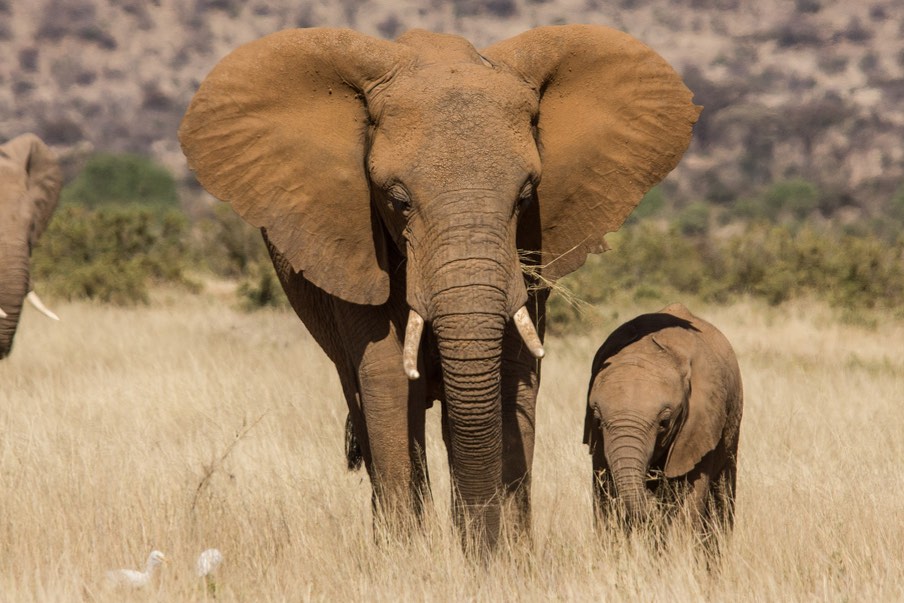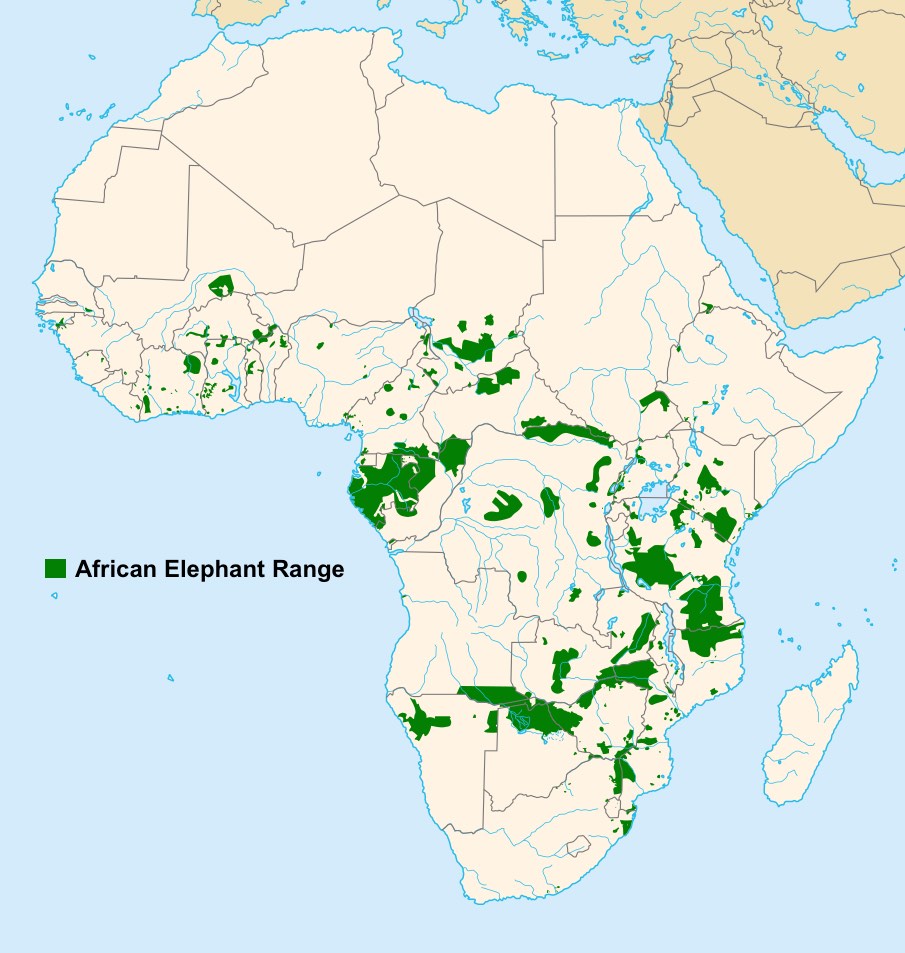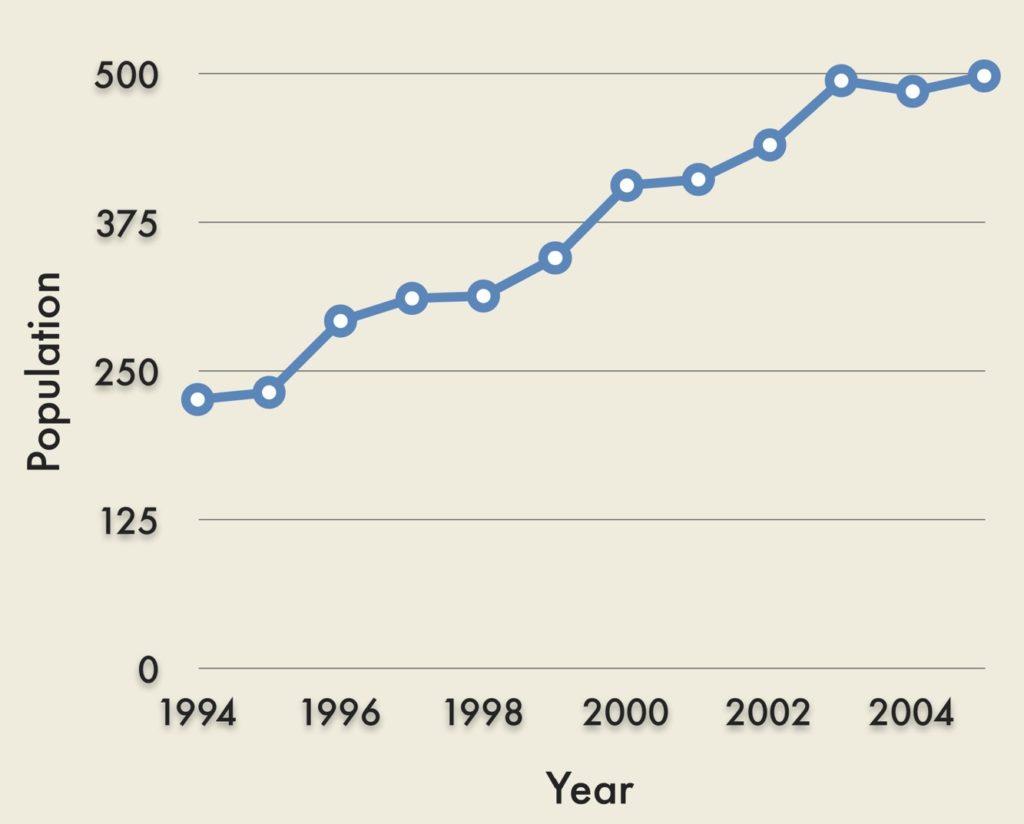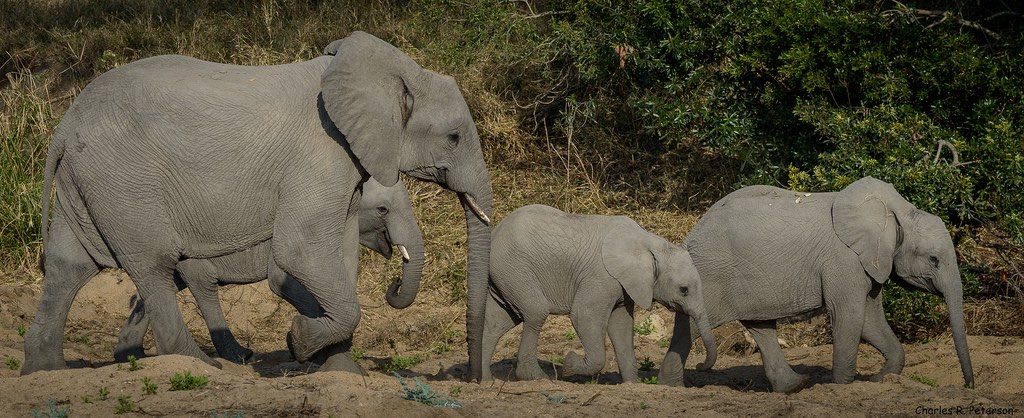Population Ecology
5.3 Elephant Contraception- Possible Solution for South Africa’s “Elephant Problem”?
Emily C. Mills
Although the African Elephant is a vulnerable species, South African national parks and reserves have started exceeding their elephant carrying capacities. Management techniques of the elephant population are required to maintain the delicate balance of the savannah ecosystem. Many different options are available, one of which is elephant contraception. But is this management option the most efficient and least damaging?

Photograph by Peter Steward, 2013. CC BY-NC 2.0.
The African elephant, Loxodonta africana, is the largest terrestrial mammal in the world and can live up to 90 years (Figure 1). Elephants are highly intelligent animals and display complex social and emotional responses, which include grieving for their dead. Their social hierarchies depend upon a matriarch elephant which leads, protects, and teaches younger females how to raise their young. Elephant communication systems are considered to be more extensive than humans can understand. They exhibit a broad range of acoustic emissions including trumpeting, braying, and a deep rumbling. In addition to their excellent auditory abilities, their feet have sensitive receptors that allow them to pick up vibrations through the ground.1

Courtesy of Bamse, 2007. CC BY-SA 3.0.
The elephant’s most prominent feature is their ivory tusks, which can grow to immense lengths if they mature to adulthood. Ivory has become a commodity, especially in locations in East Asia where ivory sculptures and fine crafts are considered status symbols (Figure 3). Asian demand helps drive the illegal ivory trade and has been a major factor in the African Elephant’s dwindling numbers over the past century.1,2 There were once abundant numbers of elephants roaming the continent of Africa, but in modern times, their range has been greatly diminished2 (Figure 2). Poaching of elephants in the twentieth century is a primary focus of African wildlife conservation. Poachers brutally kill elephants with machine guns and then hack their skulls open with machetes to gain access to their ivory tusks.3 The demand and monetary reward is so high for ivory, poachers are willing to kill young adolescents and females, whose tusks are much smaller than that of adult bull elephants. Consequently, poaching has led to many infant elephants being orphaned. For the first few years of their life, baby elephants depend on their mothers for breast milk and protection. Infant mortality is likely if their mother is killed.4 Although some African governments are rife with corruption and commonly ignore or even facilitate poaching, there has been an increasing effort to support anti-poaching teams and laws. This is especially true in highly regulated areas such as national parks and reserves.2

Photograph by Kate Miyamoto, 2013. CC BY 2.0.
Fortunately, elephants are an extremely resilient species. A study conducted by Foley and Faust focusing on the recovering elephant population in Tarangire National Park in Tanzania suggests that elephant populations can display extremely rapid growth over long time periods if they are protected and given sufficient land area and resources5 (Figure 4). South Africa’s protected areas have also become a refuge and stronghold for the African elephant. As a result, many reserves in South Africa are experiencing a boom in elephant populations, which could become an “elephant problem”.6 Elephants can cause major environmental damage by uprooting trees and eating tons of foliage, thus overpopulation threatens the balance of the surrounding ecosystem.7,8 While this population increase may be a positive trend in terms of the poaching activity across Africa, it poses a challenge for fenced-in areas such as national parks and reserves where populations must be carefully monitored due to the limited space and resources.

African elephants find refuge within Africa’s National Parks where they are more protected from poaching. Research by Foley and Faust (2010) found that elephant populations are able to recover if given protection and resources.
Data from C. A. H. Foley and L. J. Faust, 2010.
Managers of the national parks and reserves must now institute elephant population management techniques. Some of these approaches include culling, translocation, or contraception.3 In the past, culling was seen as a negative strategy for management, because it requires park rangers to gun down entire herds of elephants with automatic weapons from a helicopter. The rangers target entire herds because killing only some of the members would cause turmoil in the herd, causing infants to die, and the remaining females may scatter.3 Another option is translocation, or moving elephants from an area of higher population density to one of lower population density. This is a timely and costly venture as elephants are difficult to immobilize and transport. In addition, bulls have been known to trample over fence lines and travel hundreds of miles just to get back to where they came from, rendering translocation completely useless.9 Also, research suggests that interfering with social interactions and introducing foreign elephants into an area can cause significant increases in defensive behavior and social turmoil.10
Contraception is an increasingly enticing option for conservationists trying to control elephant populations and maintain a balanced savannah ecosystem. The most viable option is referred to as immunocontraception, a form of reducing births via vaccination of female elephants using porcine zona pellucida (pZP).11 However, concerns exist about the side effects of the vaccine and how it could affect mating behavior and herd structure.12 There is also a heavy cost involved with immunocontraception, as conservation managers must acquire the vaccines as well as the means to dispense them. Conservation managers must have access to helicopters, dart guns, and crew to properly administer the vaccines.13 Despite the logistics involved, contraception is extremely effective. The population growth is expected to be reduced to near 50%.7 A 2007 study conducted in the Greater Makalali Private Game Reserve in South Africa concluded that immunocontraception was a realistic, cost-effective management strategy for the African elephant population. Immunocontraception also minimized stress on the elephants.9 Another recent study demonstrated that immunocontraception was effective in reducing the number of calf births, and did not cause any significant behavioral, social, spatial, or resource changes over an 11-year study period.14

Photograph by Charles Peterson, 2013. CC BY-NC-ND 2.0.
In conclusion, contraception that targets female elephants seems like the most viable option for controlling the elephant populations. Alternating treatments in certain females would be necessary to maximize genetic diversity while still decreasing elephant birth rates. Unfortunately, humans have had a detrimental effect on African wildlife by pushing them out of their habitats and limiting their space and resources. The next best option to giving back the elephants’ roaming ground is to help control their population growth by the least invasive and most humane way possible.11 Immunocontraception is arguably the best option we have for addressing this issue in the most cost-effective and least-damaging manner to elephants and their environment. Further research is necessary to improve this management strategy and ensure it is being conducted with minimal detrimental effects on the African Elephant population.
References
- World Wildlife Foundation. (2011). African Elephants. WWF. Retrieved from http://wwf.panda.org/
- Blanc, J. (2008). Loxodonta Africana. IUCN 2013. IUCN Red List of Threatened Species Version 2013.2. Retrieved from http://www.iucnredlist.org/
- Eveleth, R. (2011, December 22). The Elephant in the Room: How Contraception Could Save Future Elephants from Culling. Scientific American. Retrieved from http://www.scientificamerican.com/article/the-elephant-in-the-room/
- Siebert, C. (2011, September). Elephant Poaching in Samburu. National Geographic. Retrieved from http://ngm.nationalgeographic.com/2011/09/orphan-elephants/poaching-update
- Foley, C.A.H. & Faust L.J. (2010). Rapid population growth in an elephant Loxodonta africana population recovering from poaching in Tarangire National Park, Tanzania. Oryx, 44(02): 205-212.
- The International Union for the Conservation of Nature. (2014). The Elephant Database. Retrieved from http://www.elephantdatabase.org/preview_report/2013_africa/Loxodonta_africana/2012/Africa
- Mackey, R.L., et al. (2009). Modelling the effectiveness of contraception for controlling introduced populations of elephant in South Africa. African Journal of Ecology, 47(4): 747-755.
- Scheiter, S., & Higgins, S.I. (2012). How many elephants can you fit into a conservation area. Conservation Letters, 5(3):176-185.
- Delsink, A. K., et al. (2007). Implementing immunocontraception in free-ranging African elephants at makalali conservancy. Journal of the South African Veterinary Association, 178(1): 25-30.
- Shannon, G., et al. (2013). Effects of social disruption in elephants persist decades after culling. Frontiers in Zoology, 10(63).
- Barber, M.R. & Fayrer-Hosken R.A. (2000). Possible mechanisms of mammalian immunocontraception. Journal of Reproductive Immunology, 46(2):103-124.
- Kerley, G.I.H., & Shrader, A.M. (2007). Elephant contraception: Silver bullet or a potentially bitter pill? South African Journal of Science, 103(5-6):181-182.
- Plaut, M. (2012, October 30). Will elephant contraception work in South Africa? BBC News. Retrieved from http://www.bbc.co.uk/news/world-africa-19990483
- Delsink, A. K., et al. (2013). Lack of spatial and behavioral responses to immunocontraception application in African elephants (Loxodonta africana). Journal of Zoo and Wildlife Medicine, 44(4 Suppl.): S52-74.
- Steward, Peter. (2013). [Photograph of a mother and calf African elephant in Samburu National Reserve, Kenya]. Retrieved from FlickrCommons. CC BY-NC 2.0.
- Bamse. (2007). [Range Map of the African Elephant]. Retrieved from Wikimedia Commons. CC BY-SA 3.0. Modifications: Cropped and added key.
- Miyamoto, Kate. (2013). [Photograph of ivory ornaments]. Retrieved from FlickrCommons. © U.S. Fish and Wildlife Service. CC BY 2.0.
- Peterson, Charles. (2013). [Photograph of an elephant family in South Africa]. Retrieved from FlickrCommons. CC BY-NC-ND 2.0.
